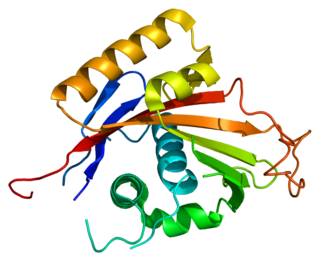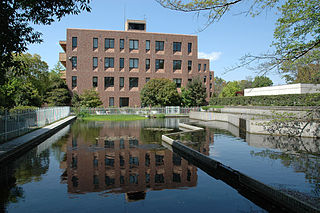Related Research Articles

Susumu Tonegawa is a Japanese scientist who was the sole recipient of the Nobel Prize for Physiology or Medicine in 1987 for his discovery of V(D)J recombination, the genetic mechanism which produces antibody diversity. Although he won the Nobel Prize for his work in immunology, Tonegawa is a molecular biologist by training and he again changed fields following his Nobel Prize win; he now studies neuroscience, examining the molecular, cellular and neuronal basis of memory formation and retrieval.

Titin is a protein that in humans is encoded by the TTN gene. Titin is a giant protein, greater than 1 µm in length, that functions as a molecular spring that is responsible for the passive elasticity of muscle. It comprises 244 individually folded protein domains connected by unstructured peptide sequences. These domains unfold when the protein is stretched and refold when the tension is removed.

Aquaporin-2 (AQP-2) is found in the apical cell membranes of the kidney's collecting duct principal cells and in intracellular vesicles located throughout the cell. It is encoded by the AQP2 gene.

Andrew Herbert Knoll is the Fisher Research Professor of Natural History and a Research Professor of Earth and Planetary Sciences at Harvard University. Born in West Reading, Pennsylvania, in 1951, Andrew Knoll graduated from Lehigh University with a Bachelor of Arts in 1973 and received his Ph.D. from Harvard University in 1977 for a dissertation titled "Studies in Archean and Early Proterozoic Paleontology." Knoll taught at Oberlin College for five years before returning to Harvard as a professor in 1982. At Harvard, he serves in the departments of Organismic and Evolutionary Biology and Earth and Planetary Sciences.

Sodium/potassium-transporting ATPase subunit alpha-2 is a protein which in humans is encoded by the ATP1A2 gene.

PHD finger protein 10 is a protein that in humans is encoded by the PHF10 gene.
Arthur W. Galston was an American plant physiologist and bioethicist. As a plant biologist, Galston studied plant hormones and the effects of light on plant development, particularly phototropism. He identified riboflavin and other flavins as the photoreceptors for phototropism, the bending of plants toward light, challenging the prevailing view that carotenoids were responsible.

Alkaline phosphatase, intestinal also known as ALPI is a type of alkaline phosphatase that in humans is encoded by the ALPI gene.

The National Institute for Basic Biology (NIBB) is a research institute and post graduate university in Okazaki City, Aichi Prefecture, Japan. It was founded in 1977 to promote biological research in Japan in cooperation with public and private universities, and research institutes.

Robert William Hamilton Jr., known as Bill, was an American physiologist known for his work in hyperbaric physiology.

Neal Pollock is a Canadian academic and diver. Born in Edmonton, Canada he completed a bachelor's degree in zoology; the first three years at University of Alberta and the final year at the University of British Columbia. After completing a master's degree he then served as diving officer at University of British Columbia for almost five years. He then moved to Florida and completed a doctorate in exercise physiology/environmental physiology at Florida State University.

Satoshi Ōmura is a Japanese biochemist. He is known for the discovery and development of hundreds of pharmaceuticals originally occurring in microorganisms. In 2015, he was awarded the Nobel Prize in Physiology or Medicine jointly with William C. Campbell for their role in the discovery of avermectins and ivermectin, the world's first endectocide and a safe and highly effective microfilaricide. It is believed that the large molecular size of ivermectin prevents it from crossing the blood/aqueous humour barrier, and renders the drug an important treatment of helminthically-derived blindness.
Sudhir Kumar Sopory is an Indian educationist, plant physiologist, scientist and former vice chancellor of Jawaharlal Nehru University, New Delhi. He is known to be the first to purify a protein kinase C activity from plants and is credited with the identification of topoisomerase as a substrate of protein kinase C. He is an elected Fellow of several major Indian science academies and The World Academy of Sciences (TWAS) and is a recipient of many honours, including the 1987 Shanti Swarup Bhatangar Prize, the highest Indian award in the science and technology categories. The Government of India awarded him the fourth highest civilian honour of the Padma Shri, in 2007, for his contributions to science and technology.

Alizade Valida Movsum gizi is an Azerbaijani doctor of biological sciences, professor, full member (academician) of Azerbaijan National Academy of Sciences (ANAS) and the Director of the Institute of Botany ANAS.
Prafullachandra Vishnu Sane is an Indian molecular biologist and plant physiologist, known for his pioneering studies on photosynthesis. He is a former director of National Botanical Research Institute and an elected fellow of the Indian Academy of Sciences, Indian National Science Academy, National Academy of Sciences, India, National Academy of Agricultural Sciences and the Maharashtra Academy of Sciences. The Council of Scientific and Industrial Research, the apex agency of the Government of India for scientific research, awarded him the Shanti Swarup Bhatnagar Prize for Science and Technology, one of the highest Indian science awards, in 1981, for his contributions to biological sciences.
Akhilesh Kumar Tyagi is an Indian plant biologist and the former director of National Institute of Plant Genome Research. Known for his studies on plant genomics and biotechnology, Tyagi is an elected fellow of all the three major Indian science academies namely Indian Academy of Sciences, Indian National Science Academy and National Academy of Sciences, India as well as The World Academy of Sciences and the National Academy of Agricultural Sciences. The Department of Biotechnology of the Government of India awarded him the National Bioscience Award for Career Development, one of the highest Indian science awards, for his contributions to biosciences in 1999.
Anil Grover is an Indian molecular biologist, professor and the head of the Department of Plant Molecular Biology at the University of Delhi. He also heads the Anil Grover Lab of the department, serving as the principal investigator. Known for his research in the field of molecular biology of plants, Grover is an elected fellow of all the three major Indian science academies namely the National Academy of Sciences, India, the Indian Academy of Sciences and the Indian National Science Academy as well as the National Academy of Agricultural Sciences. The Department of Biotechnology of the Government of India awarded him the National Bioscience Award for Career Development, one of the highest Indian science awards, for his contributions to biosciences in 2002.
Girdhar Kumar Pandey is an Indian molecular biologist, biochemist, biotechnologist, and a professor at the department of plant molecular biology of the South Campus of the University of Delhi. He is known for his studies on the signal transduction pathways in Arabidopsis (rockcress) and Oryza sativa (rice) and is an elected fellow of the National Academy of Sciences, India and the National Academy of Agricultural Sciences. The Department of Biotechnology of the Government of India awarded him the National Bioscience Award for Career Development, one of the highest Indian science awards, for his contributions to biosciences, in 2015.
Toshifumi (Toshi) Yokota is a medical scientist and professor of medical genetics at the University of Alberta, where he also holds the titles of the Friends of Garrett Cumming Research & Muscular Dystrophy Canada Endowed Research Chair and the Henri M. Toupin Chair in Neurological Science. He is best known for his studies of antisense oligonucleotide-based therapeutics for muscular dystrophy that led to the development of an FDA-approved drug viltolarsen. His research interests include precision medicine for muscular dystrophy and genetic diseases. He has co-edited two books both published in the Methods in Molecular Biology series from Humana Press, Springer-Nature, and has published more than 100 refereed papers and patents. He is a member of the editorial boards for the International Journal of Molecular Sciences, Genes, Frontiers in Genome Editing, Frontiers in Physiology, and Nucleic Acid Therapeutics, a member of the Medical and Scientific Advisory Committee of Muscular Dystrophy Canada, and a co-founder of the Canadian Neuromuscular Network (CAN-NMD).

Masashi Yanagisawa is a Japanese-American molecular biologist and physician, famous for his discovery of the hormone endothelin and the neuropeptide orexin, the absence of which is the cause of narcolepsy. He is currently the Director of the International Institute for Integrative Sleep Medicine, University of Tsukuba, and an adjunct professor at the Department of Molecular Genetics, University of Texas Southwestern Medical Center.
References
- ↑ "Kyonoshin Maruyama". Google Scholar . Retrieved December 13, 2013.
- ↑ MA Rabbani, K Maruyama, H Abe, MA Khan, K Katsura, Y Ito, K Yoshiwara, M .. "Monitoring expression profiles of rice genes under cold, drought, and high-salinity stresses and abscisic acid application using cDNA microarray and RNA gel-blot analyses".Plant physiology 133 (4), 1755-1767 (2003)